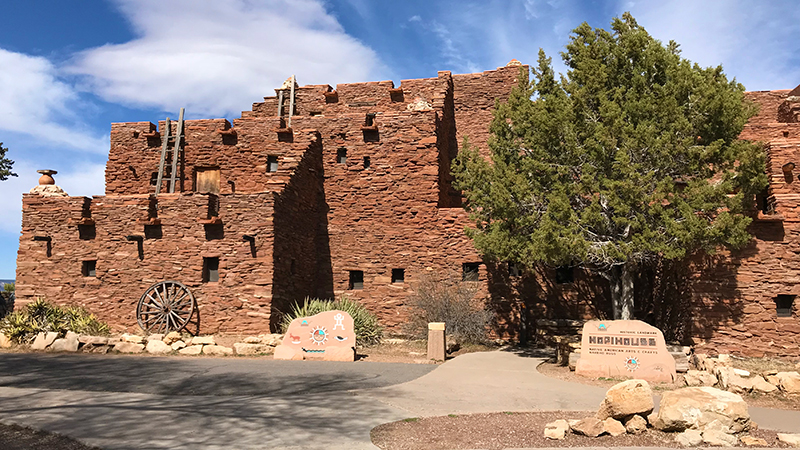
After visiting Verkamp’s Visitor Center, we walked along the South Rim Trail to explore Grand Canyon Village. The views along the trail are stunning, viewing telescopes are set periodically with key formations marked for you to see, and historic buildings, some perched right on the edge of the canyon rim, are open for you to tour freely. While Grand Canyon Village was very crowded, we enjoyed checking out Hopi House, the El Tovar Hotel, Lookout Studio, Kolb Studio, and the trailhead for the famous Bright Angel Trail. We also stopped in the Yavapai Geology Museum before heading back to our hotel for dinner.
Hopi House, located on the South Rim of the Grand Canyon, was commissioned in 1904 and built in 1905 by the Fred Harvey Company as a market for Native American crafts, made by artisans on the site. Modeled after the 10,000 year-old pueblo dwellings of the Hopi village in Old Oraibi, Arizona, Hopi House is the first of eight projects at Grand Canyon designed by architect Mary Colter.
Colter also designed Bright Angel Lodge, Hermit’s Rest, Lookout Studio, Phantom Ranch, and Desert View Watchtower, as well as two employee dormitories, Colter Hall, and Victor Hall.
Hopi House is a rectangular, three-story stone masonry building with terraced roofs and mesquite/pinyon wood ladders provide access to the terraces on each level. The mixed sandstone block walls are reddish in color, and tiny windows, like those of traditional Hopi structures, allow only the smallest amount of light into the building.
- Interior walls are plastered with adobe, while ceilings are composed of saplings, twigs and grass covered with mud.
- The old staircase to the second floor is decorated with murals by an unknown Hopi artist.
- Fireplaces are located in the corners of rooms.
- The second floor houses a shrine, called a kiva, with Hopi religious artifacts.
- The third floor was used as an apartment for the building’s former managers but is now used for storage.
- Most of the original furnishings in the main level, were picked out by Colter, have been preserved.
Mary Colter And Hopi House
Mary Colter was commissioned in 1904 by the Fred Harvey Company to design an Indian Arts Building that was to be built across from the El Tovar Hotel. The souvenir shop would feature local Indian arts and crafts and as the historic inhabitants of the area, the Hopi were chosen as the featured artisans.
One of just a few women in a male-dominated field, Colter was inspired by the natural beauty of the Grand Canyon and wanted to design something that appeared native, natural, and timeless. The building represented the puebloan architecture of traditional Hopi dwellings, except, unlike traditional Hopi dwellings, there is no roof entrance. Instead Hopi House was given a front door so tourists could easily access and purchase the beautiful Native American arts and crafts.
Planned as a living museum, Hopi House opened on January 1, 1905, two weeks before the El Tovar Hotel and inside, Mary Colter’s unique touches can still be seen. Corner fireplaces with chimneys are made from broken pottery jars stacked and mortared together. Baskets hang from peeled log beams and low ceilings thatched with young saplings. Kachina dolls, ceremonial masks, and woodcarvings are displayed in niche-filled mud-plastered walls. Pottery and jewelry are arranged for inspection on counters draped in hand-woven Navajo blankets and rugs.
Know Before You Go
- Hopi House, built in 1905, is located across from the El Tovar Hotel in Grand Canyon Village, Arizona 86023 in Coconino County in Grand Canyon National Park.
- Hopi House is open from 9:00 am to 5:00 pm.
- Stop in to browse the two-story gift shop featuring native arts and crafts. But beware, it’s small, the ceilings are low, there’s A LOT stuffed in there, and when you add tourists, it gets hot and cramped fast!
- Hopi House was designated a National Historic Landmark as part of the Mary Jane Colter Buildings collective nomination in 1987. The nomination includes the Desert View Watchtower, Hopi House, Lookout Studio, and Hermit’s Rest.
- Hopi House and the Lookout Studio are also major contributing structures in the Grand Canyon Village National Historic Landmark District.
- Directly across the street is the El Tovar Hotel. Walk west to reach Lookout Studio, Kolb Studio, the Bright Angel Trail, Hermit Road, and Hermit’s Rest, or east along the Canyon Rim Trail to Verkamp’s Visitor Center, Yavapai Geology Museum, Mather Point, Grand Canyon Visitor Center, and Desert View Drive.
- The Grand Canyon South Rim, including Grand Canyon Village and Desert View, is open 24 hours a day, 365 days a year.
- A free shuttle bus system operates on the South Rim connecting the visitor centers, parking lots, lodges and hotels, historic buildings, museums, and campgrounds with canyon overlooks. The Blue Shuttle serves Grand Canyon Village.







